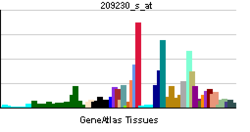- NUPR1
-
Nuclear protein, transcriptional regulator, 1 Identifiers Symbols NUPR1; COM1; P8 External IDs MGI: 1891834 HomoloGene: 8229 GeneCards: NUPR1 Gene Gene Ontology Molecular function • molecular_function Cellular component • nucleus Biological process • induction of apoptosis
• cell growthSources: Amigo / QuickGO RNA expression pattern 
More reference expression data Orthologs Species Human Mouse Entrez 26471 56312 Ensembl ENSG00000176046 ENSMUSG00000030717 UniProt O60356 Q9D756 RefSeq (mRNA) NM_001042483.1 NM_019738.1 RefSeq (protein) NP_001035948.1 NP_062712.1 Location (UCSC) Chr 16:
28.55 – 28.55 MbChr 7:
133.77 – 133.77 MbPubMed search [1] [2] Nuclear protein 1 is a protein that in humans is encoded by the NUPR1 gene.[1][2][3][4]
References
- ^ Mallo GV, Fiedler F, Calvo EL, Ortiz EM, Vasseur S, Keim V, Morisset J, Iovanna JL (Jan 1998). "Cloning and expression of the rat p8 cDNA, a new gene activated in pancreas during the acute phase of pancreatitis, pancreatic development, and regeneration, and which promotes cellular growth". J Biol Chem 272 (51): 32360–9. doi:10.1074/jbc.272.51.32360. PMID 9405444.
- ^ Ree AH, Tvermyr M, Engebraaten O, Rooman M, Rosok O, Hovig E, Meza-Zepeda LA, Bruland OS, Fodstad O (Oct 1999). "Expression of a novel factor in human breast cancer cells with metastatic potential". Cancer Res 59 (18): 4675–80. PMID 10493524.
- ^ Vasseur S, Vidal Mallo G, Fiedler F, Bodeker H, Canepa E, Moreno S, Iovanna JL (Apr 1999). "Cloning and expression of the human p8, a nuclear protein with mitogenic activity". Eur J Biochem 259 (3): 670–5. doi:10.1046/j.1432-1327.1999.00092.x. PMID 10092851.
- ^ "Entrez Gene: NUPR1 nuclear protein 1". http://www.ncbi.nlm.nih.gov/sites/entrez?Db=gene&Cmd=ShowDetailView&TermToSearch=26471.
Further reading
- Loftus BJ, Kim UJ, Sneddon VP, et al. (1999). "Genome duplications and other features in 12 Mb of DNA sequence from human chromosome 16p and 16q.". Genomics 60 (3): 295–308. doi:10.1006/geno.1999.5927. PMID 10493829.
- Hoffmeister A, Ropolo A, Vasseur S, et al. (2002). "The HMG-I/Y-related protein p8 binds to p300 and Pax2 trans-activation domain-interacting protein to regulate the trans-activation activity of the Pax2A and Pax2B transcription factors on the glucagon gene promoter.". J. Biol. Chem. 277 (25): 22314–9. doi:10.1074/jbc.M201657200. PMID 11940591.
- Ree AH, Bratland A, Kroes RA, et al. (2002). "Clinical and cell line specific expression profiles of a human gene identified in experimental central nervous system metastases.". Anticancer Res. 22 (4): 1949–57. PMID 12174869.
- Strausberg RL, Feingold EA, Grouse LH, et al. (2003). "Generation and initial analysis of more than 15,000 full-length human and mouse cDNA sequences.". Proc. Natl. Acad. Sci. U.S.A. 99 (26): 16899–903. doi:10.1073/pnas.242603899. PMC 139241. PMID 12477932. http://www.pubmedcentral.nih.gov/articlerender.fcgi?tool=pmcentrez&artid=139241.
- Suzuki Y, Yamashita R, Shirota M, et al. (2004). "Sequence comparison of human and mouse genes reveals a homologous block structure in the promoter regions.". Genome Res. 14 (9): 1711–8. doi:10.1101/gr.2435604. PMC 515316. PMID 15342556. http://www.pubmedcentral.nih.gov/articlerender.fcgi?tool=pmcentrez&artid=515316.
- Gerhard DS, Wagner L, Feingold EA, et al. (2004). "The status, quality, and expansion of the NIH full-length cDNA project: the Mammalian Gene Collection (MGC).". Genome Res. 14 (10B): 2121–7. doi:10.1101/gr.2596504. PMC 528928. PMID 15489334. http://www.pubmedcentral.nih.gov/articlerender.fcgi?tool=pmcentrez&artid=528928.
- Jiang WG, Davies G, Fodstad O (2005). "Com-1/P8 in oestrogen regulated growth of breast cancer cells, the ER-beta connection.". Biochem. Biophys. Res. Commun. 330 (1): 253–62. doi:10.1016/j.bbrc.2005.02.157. PMID 15781258.
- Mao Y, Zhao Y, Zhou LF, et al. (2006). "A novel gene mutation (1292 deletion) in a Chinese family with cerebral cavernous malformations.". Neurosurgery 56 (5): 1149–53; discussion 1149–53. PMID 15854263.
- Ito Y, Yoshida H, Motoo Y, et al. (2005). "Expression of p8 protein in medullary thyroid carcinoma.". Anticancer Res. 25 (5): 3419–23. PMID 16101158.
- Valacco MP, Varone C, Malicet C, et al. (2006). "Cell growth-dependent subcellular localization of p8.". J. Cell. Biochem. 97 (5): 1066–79. doi:10.1002/jcb.20682. PMID 16294328.
- Malicet C, Hoffmeister A, Moreno S, et al. (2006). "Interaction of the stress protein p8 with Jab1 is required for Jab1-dependent p27 nuclear-to-cytoplasm translocation.". Biochem. Biophys. Res. Commun. 339 (1): 284–9. doi:10.1016/j.bbrc.2005.11.018. PMID 16300740.
- Malicet C, Giroux V, Vasseur S, et al. (2006). "Regulation of apoptosis by the p8/prothymosin alpha complex.". Proc. Natl. Acad. Sci. U.S.A. 103 (8): 2671–6. doi:10.1073/pnas.0508955103. PMC 1413786. PMID 16478804. http://www.pubmedcentral.nih.gov/articlerender.fcgi?tool=pmcentrez&artid=1413786.
- Malicet C, Dagorn JC, Neira JL, Iovanna JL (2006). "p8 and prothymosin alpha: unity is strength.". Cell Cycle 5 (8): 829–30. PMID 16628001.
- Jiang WG, Davies G, Martin TA, et al. (2007). "Com-1/p8 acts as a putative tumour suppressor in prostate cancer.". Int. J. Mol. Med. 18 (5): 981–6. PMID 17016631.
- Ishida M, Miyamoto M, Naitoh S, et al. (2007). "The SYT-SSX fusion protein down-regulates the cell proliferation regulator COM1 in t(x;18) synovial sarcoma.". Mol. Cell. Biol. 27 (4): 1348–55. doi:10.1128/MCB.00658-06. PMC 1800732. PMID 17101797. http://www.pubmedcentral.nih.gov/articlerender.fcgi?tool=pmcentrez&artid=1800732.
- Goruppi S, Patten RD, Force T, Kyriakis JM (2007). "Helix-loop-helix protein p8, a transcriptional regulator required for cardiomyocyte hypertrophy and cardiac fibroblast matrix metalloprotease induction.". Mol. Cell. Biol. 27 (3): 993–1006. doi:10.1128/MCB.00996-06. PMC 1800682. PMID 17116693. http://www.pubmedcentral.nih.gov/articlerender.fcgi?tool=pmcentrez&artid=1800682.
Categories:- Human proteins
- Chromosome 16 gene stubs
Wikimedia Foundation. 2010.
